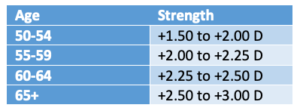It’s hard to imagine anything affecting 1.8 billion people but presbyopia did so in 2015 (source). Today, presbyopia affects even more individuals over the age of 40 and in particular those aged 65+. What is this mysterious problem and how can you prepare or prevent it?
To help you understand presbyopia, consider the following story:
Frank and Elaine go out to their 35th wedding anniversary dinner at their favorite restaurant. On their anniversary, Frank always likes to pick out what to order from the menu as it reminds them of their first date.
With a smile, Elaine puts the menu down and sips her water giving Frank the unspoken go-ahead to proceed.
As Frank lifts up the menu in the romantic ambiance of low lighting he stares with a deep, puzzling look at what is a very familiar menu. He starts to sweat and become anxious as he can’t read the blurry words on the page like he used to.
Elaine notices this and nonchalantly hands Frank her reading glasses which he begrudgingly uses to select their three favorites dishes.
If this sounds at all familiar to a personal experience or one you have observed, then you know about presbyopia all too well.
What is Presbyopia?
Presbyopia is absolutely normal and is the natural change in your eyes to gradually lose the ability to see things up close. This will typically start around the age of 40 and progressively worsen until the age of 65. As the eye ages, the lens of the eye becomes more and more inflexible. The inflexibility that we have in our youth, makes it harder to focus on items nearby – especially reading.
According to Harvard Medical School, “In order for us to see images clearly, light rays enter the eye, where the lens bends and focuses the rays on the retina. The lens changes shape to allow the eye to focus on objects at different distances.
Beginning early in life — perhaps as early as age 10 — our lenses gradually stiffen and begin to lose the ability to change shape.
By the time we are in our 40s, the lens has trouble focusing up close, and we begin to experience blurred vision when we try to do tasks that require up-close focus, such as reading or needlework.
The lens continues to stiffen until about age 65 when nearly all its flexibility has been lost.”
What are Common Symptoms of Presbyopia?
You are likely to notice symptoms after the age of 40. If you already wear glass or contacts, you may still notice changes in the clarity of items up close. If you are above the age of 40 and notice any of the following symptoms on a consistent basis you should schedule an eye exam with your eye doctor.
- Having to hold reading material further away from your face to focus on letters (having a hard time focusing)
- Blurry vision with what is considered a normal reading distance away
- Feeling a headache or eye strain after regular reading or general concentration on an object nearby
What are Risk Factors for Presbyopia?
Age is the most significant factor that causes presbyopia but there are other conditions and lifestyles that may increase the pace of the eye change. Some of the additional risk factors include:
- Diabetes
- Cardiovascular disease
- Anemia
- Poor blood flow
- Eye trauma
How to Address Presbyopia?
To treat presbyopia, you have three primary options: wear corrective lenses, wear contact lenses or explore corrective surgery.
How Do You Choose Corrective, Non-Prescriptive Glasses?
Reading glasses are extremely common and likely anyone over the age of 65 will need some version of them. As you experience presbyopia, wearing reading glasses will give you the general comfort and level of independence you once had. When choosing a pair of reading glasses, first consider the power of the lenses you may need. Here is an easy-to-follow chart:
The Power-Grid of Reading Glasses by Age

If you are not sure about the power or the grid isn’t accurate for you, start with just using the lower power +1.5 (if aged 50+) and see how it impacts your focus and vision. Once you narrow it down, test out the glasses in the store for a quick assessment. See how well the glasses correct presbyopia for you.
In the end, presbyopia is a natural change in your eyesight. It is something we will all have to wrestle with. Take steps now to become familiar with presbyopia, losing focus and how to select a good pair of reading glasses.

